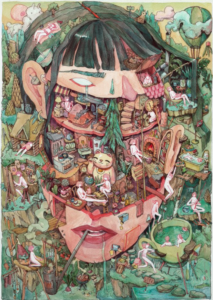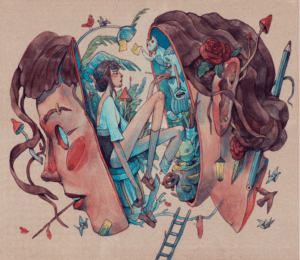S.T Gamage
Colombo, Sri Lanka
 |
| Where the thoughts live by Marija Tiurina. Published with permission. |
“They say there’s no harm in daydreaming, but there is.”
— Charlaine Harris
An excessive amount of daydreaming can lead to a psychological condition called maladaptive daydreaming (MD). It is also known as daydreaming disorder. Professor Eliezer Somer from the University of Haifa, Israel, first identified this condition. It is a disorder that causes extremely vivid daydreams with their own characters, settings, plot, and other details that can stop one from engaging in day to day life. Experts are still unsure what causes maladaptive daydreaming, but they believe it may be a coping mechanism to respond to childhood trauma, abuse, loneliness, and depression. This condition does not have an official treatment.
Various things made me a maladaptive daydreamer. Being part of a male-dominated society always made me daydream about how my life would be different and privileged if I were a boy instead of a girl. Growing up with no siblings, I ended up lonely. There was no one to be with me. I spent my days wandering alone. Although I made friends, my friend circle did not last long. There were some people beside me, but I felt a massive distance from them. To cope with loneliness, I created my own little world inside my head. I had my own people there. That is how I started to daydream as a child.
When I was young, the daydreaming world used to be peaceful. The variety of characters always made me enthusiastic about the story. We were happy together. The content of daydreams was highly detailed and lengthy. It looked like a TV series that gets updated with a new episode every day. Sometimes, I stuck to the same plot and kept repeating it for days. Daydreaming bought me much happiness. It was my way to escape reality and my way to live. In real life, people left me for various reasons. But my imaginary characters never did. They were always there for me. You cannot get abandoned by your own characters. No wonder I got addicted. Unlike in real life, I had complete control of removing or welcoming people into my life. That was fun.
 |
| STAYCATION by Lê Long. Published with permission. |
At some point in my life, daydreaming became a constant addiction. I would come home from school and go straight to somewhere quiet to start daydreaming. I added all the exciting scenarios that happened in school each day. Every day I dreamed for hours and hours without doing any schoolwork. The next morning, I continued the remaining plot and was late for school. It came to the point that I skipped school to daydream. Meanwhile, I ended up missing a lot of exams. My grades went down, and I was weak in math and science. I always ended up in the low marks group. Because of my low self-esteem, I could not express myself well and was always anxious about what others thought of me. Now daydreaming caused trouble in my life. It was no longer peaceful. My parents were frustrated and told me to stop. But habitual actions are hard to break. Sometimes my mother thought this was a small phase of life and I may eventually stop. Even I felt the same way, but this was not true. I became more anxious and frustrated each time I stopped daydreaming.
It took eighteen years of my life to find out I am a maladaptive daydreamer. I never thought I had a psychological disorder. After knowing that, I was devastated. My world was completely shattered. I felt pathetic. Those emotions made me turn back to see what I had lost in my life. I lost the most important thing, which is time. I lost time to be with loved ones. I lost time to make new friends. I lost time to improve myself. It seems like I lost everything. Years I wasted on a non-existent world will never come back. Everyone is ahead of me. I am left behind. No improvement. No hope. No future.
 |
|
Inside her head by Marija Tiurina. Published with permission. |
I tried to seek medical help, but the doctor said there is no such thing as maladaptive daydreaming. Since I was already taking medicine for anxiety, I could not afford to pay another doctor. I decided to overcome this on my own. To do it, I realized what kept me daydreaming. It was satisfaction, which I felt through my characters. All my characters were the opposite of me. Unlike me, they were talented, confident, independent, and fearless. This is exactly what I wanted to be. Instead of working on myself, I tried to get there through fictional characters. Slowly I focused on reducing the time I used for daydreaming. That was hard because I spent more than seven hours a day daydreaming. I started to engage in more physical activities. Steadily I started to connect with real people. Thanks to the improvement, I built a good bond with my mother. I am trying to learn something new to distract myself from daydreaming. I set small goals to achieve each day. Little by little, I challenge myself.
Maladaptive daydreaming should be taken more seriously. It is a condition no one talks about. It can cause harm and lead to other mental disorders. I hope experts will work to find an official cure for daydreaming disorder. Otherwise, daydreamers like me will be forever lost in fantasies.
S.T GAMAGE is a student and a patient under medical care. She is interested in arts, social science, cultures and societies, creative writing, and mental health. She is aspiring to be an artist.
Summer 2021 | Sections | Psychiatry & Psychology

Leave a Reply